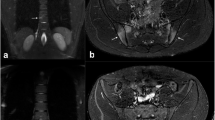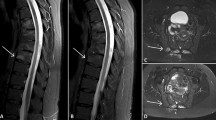Summary
Painful, aseptic osteitis remains the major problem in the treatment of patients with SAPHO syndrome. We present a child suffering of both sacroiliitis and acne conglobata in the context of SAPHO syndrome. While acne lesions responded well to systemic isotretinoin, sacroiliitis associated pain could be controlled neither by NSAR nor by intralesional or systemic steroid injection. Worse pain limited substantially patient's mobility. This changed immediately after starting etanercept. Within a few days, pain resolved and the patient regained his mobility. This favourable response lasted for 8 months when we tried to stop etanercept under protection with the DMARD sulfazalazin. Unfortunately, within a few days, pain and immobility re-occurred requiring reinstitution of etanercept. This case demonstrates that, similar to other reports, TNF blockade is able to induce prompt and long-lasting response of SAPHO syndrome associated osteoarthritis to TNF blockade.
Zusammenfassung
Beim SAPHO-Syndrom stellen die aseptischen, schmerzhaften Osteitiden oft ein großes therapeutisches Problem dar. Wir stellen einen Patienten vor, der sowohl an einer Sakroileitis als auch an einer Akne conglobata im Rahmen eines SAPHO-Syndroms litt. Während die Akneläsionen sehr gut auf eine Therapie mit Isotretinoin ansprachen, waren die durch die Sacroileitis verursachten Schmerzen mittels NSAR und Steroidapplikationen (lokal und systemisch) nicht anhaltend zu beeinflussen. Sie führten zu einer massiven Beeinträchtigung seiner Mobilität. Dieser Zustand änderte sich prompt nach Einleitung einer Therapie mit Etanercept. Innerhalb weniger Tage sistierten die Schmerzen, die Beweglichkeit kehrte zurück. Der Patient war bis zu einem Etanercept-Auslassversuch, der 8 Monate nach Therapiebeginn unter DMARD-Schutz erfolgte, beschwerdefrei. Innerhalb weniger Tage rezidivierten die Beschwerden derart, dass Etanercept wieder begonnen werden musste. Unser Fall zeigt, ähnlich wie bisher in der Literatur in Einzelfallberichten beschrieben, dass die Gabe von TNF-Blockern zu einer schnellen und anhaltenden Besserung der osteoartikulären Beschwerden beim SAPHO-Syndrom führt.
Similar content being viewed by others
Literatur
Chamot AM, Benhamou CL, Kahn MF, et al. Acne-pustulosis-hyperostosis-osteitis syndrome. Results of a national survey. 85 cases. Rev Rhum Mal Osteoartic, 54: 187–196, 1987
Beretta-Piccoli, BC, Sauvain MJ, Gal I, et al. Synovitis, acne, pustulosis, hyperostosis, osteitis (SAPHO) syndrome in childhood: a report of ten cases and review of the literature. Eur J Pediatr 159: 594–601, 2000
Vignon-Pennamen MD. The extracutaneous involvement in the neutrophilic dermatoses. Clin Dermatol 18: 339–347, 2000
Colina M, Govoni M, Orzincolo C, et al. Clinical and radiologic evolution of synovitis, acne, pustulosis, hyperostosis, and osteitis syndrome: a single center study of a cohort of 71 subjects. Arthritis Rheum, 61: 813–821, 2009
Colina M, La Corte R, Trotta F. Sustained remission of SAPHO syndrome with pamidronate: a follow-up of fourteen cases and a review of the literature. Clin Exp Rheumatol, 27: 112–115, 2009
Hurtado-Nedelec M, Chollet-Martin S, Nicaise-Roland P, et al. Characterization of the immune response in the synovitis, acne, pustulosis, hyperostosis, osteitis (SAPHO) syndrome. Rheumatology (Oxford), 47: 1160–1167, 2008
Chamot AM, Kahn MF. SAPHO syndrome. Z Rheumatol, 53: 234–242, 1994
Olivieri I, Padula A, Palazzi C. Pharmacological management of SAPHO syndrome. Expert Opin Investig Drugs, 15: 1229–1233, 2006
Kopterides P, Pikazis D, Koufos C. Successful treatment of SAPHO syndrome with zoledronic acid. Arthritis Rheum, 50: 2970–2973, 2004
Simm PJ, Allen RC, Zacharin MR. Bisphosphonate treatment in chronic recurrent multifocal osteomyelitis. J Pediatr, 152: 571–575, 2008
Galadari H, Bishop AG, Venna SS, et al. Synovitis, acne, pustulosis, hyperostosis, and osteitis syndrome treated with a combination of isotretinoin and pamidronate. J Am Acad Dermatol, 61: 123–125, 2009
Wagner AD, Andresen J, Jendro MC, et al. Sustained response to tumor necrosis factor alpha-blocking agents in two patients with SAPHO syndrome. Arthritis Rheum, 46: 1965–1968, 2002
Moll C, Hernandez MV, Canete JD, et al. Ilium osteitis as the main manifestation of the SAPHO syndrome: response to infliximab therapy and review of the literature. Semin Arthritis Rheum, 37: 299–306, 2008
Author information
Authors and Affiliations
Corresponding author
Rights and permissions
About this article
Cite this article
Wolber, C., David-Jelinek, K., Udvardi, A. et al. Sacroileitis im Rahmen eines SAPHO Syndroms – promptes Ansprechen auf Etanercept. Wien Med Wochenschr 161, 204–208 (2011). https://doi.org/10.1007/s10354-010-0852-8
Received:
Accepted:
Published:
Issue Date:
DOI: https://doi.org/10.1007/s10354-010-0852-8




